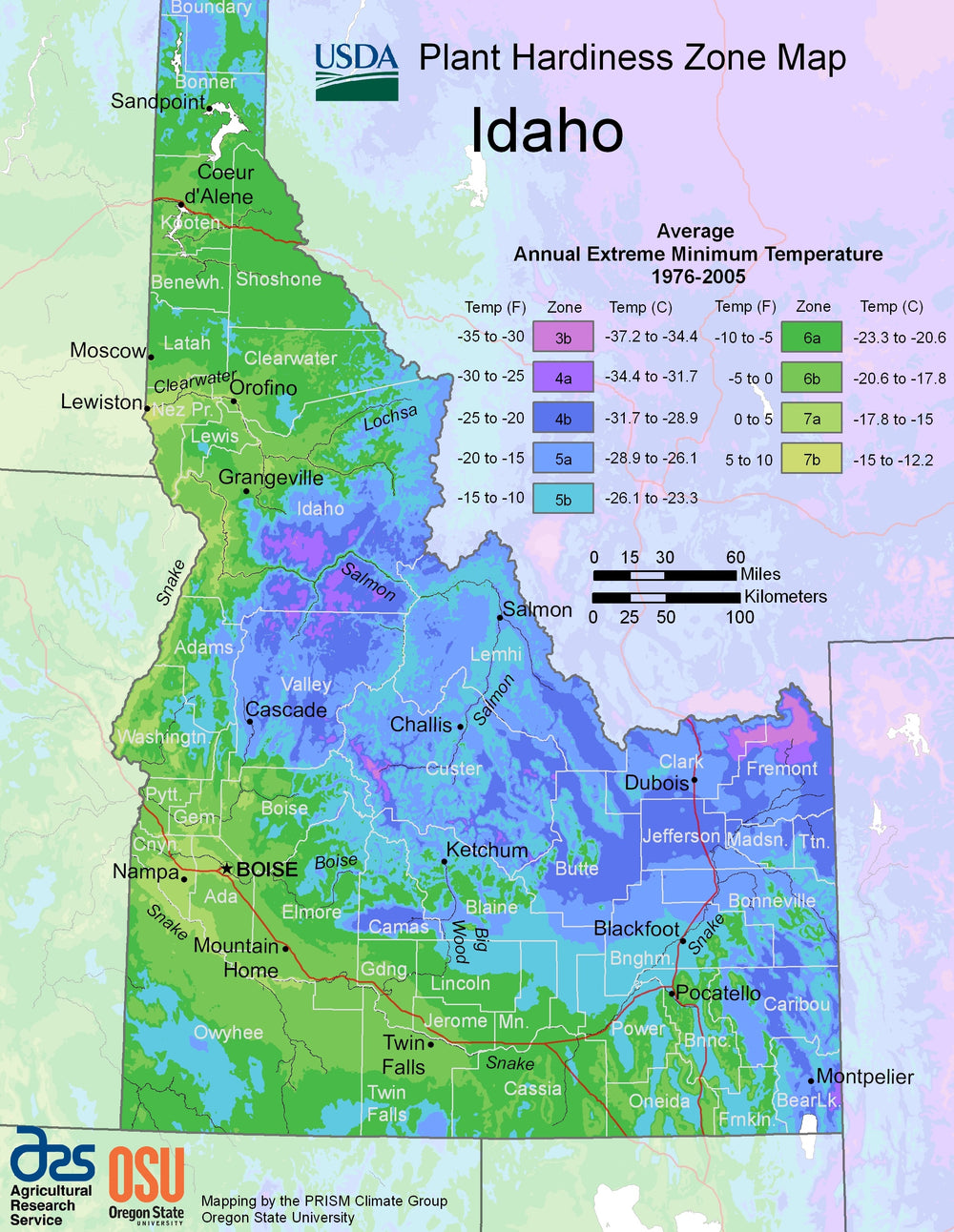Image from the USDA
Characteristics of Idaho Planting Region
The state of Idaho experiences two relatively distinct climates:
- The northern and western regions will endure humid, cloudy, and wet winters resulting from maritime influence.
-
The eastern and southern parts of the state experience a semi-arid continental climate with dry and cold winters.

McCall, Idaho | Photo by Drew Lindsley on Unsplash
Other characteristics of Idaho growing region include:
- Thunderstorms
- Wildfires
- High winds
- Heavy snowfall
- Flooding
Across most of the country, summers will be warm to hot with several sunny days. However, frost-free periods will vary drastically across the region, so it’s best to find the average dates specific to your area.

Payette National Forest, McCall, Idaho | Photo by Porter Raab on Unsplash
Challenges of Growing in Idaho
1. Diverse Climate
The variation in the terrain and climate across the state makes a standardized hardiness measure challenging to follow at times. Although the USDA growing zones can be a good starting point, they can also be misleading for planting in specific areas of this state.
2. Unpredictable Weather
Planning ahead isn’t always an option. Idaho regularly experiences unpredictable weather, from high winds to floods. Having an elevated and protected garden is necessary for certain areas throughout the region.
3. High Elevation
Much of Idaho sits at a high altitude. The average elevation is around 5000 feet and drastically varies depending on the area. This can be complicated for gardeners since winter minimum temperatures change with every few hundred feet in elevation.

Pocatello, Idaho | Photo by Mitchell Kmetz on Unsplash
The Benefits of Using a Greenhouse in Idaho
The unpredictable weather and varying climates make Idaho an ideal region for a greenhouse. Regardless of where you may be located in the state, all greenhouse users can enjoy an extended growing season through the winter months and protection from temperamental weather.
1. Extend your growing season
-
Without a greenhouse:
The standard planting season in Idaho drastically varies across the state but tends not to last longer than three months. The short growing season and higher elevation of the state mean that many vegetables will struggle to survive without some indoor growing assistance.
-
With a greenhouse:
A greenhouse can help extend your planting season in Idaho by several months. On average, you can expect 7-9 months of uninterrupted growing time, making a greenhouse a wise investment to maximize planting time throughout the year.
Learn more about specific growing dates for your area and the best vegetables to plant in each part of Idaho.


Customer images of the Ministar and Sungrow greenhouses in similar climate regions
2. Grow a Wider Variety of Vegetables
-
Without a greenhouse:
Outdoor gardeners are limited in their vegetable options due to unpredictable weather and the region’s higher altitude. Some vegetables known to survive in this climate without indoor growing assistance include:
- Lettuce
- Kale
- Peas
- Radishes
- Onions
- Sugarbeets
-
With a greenhouse:
A wide variety of plants can grow comfortably in a greenhouse within this region. Gardeners can easily plant tender warm-season crops without needing to transplant at a later date or worry about late/early frosts. Some of the best vegetables suggested for greenhouse growing include:
- Beans
- Potatoes
- Sweet corn
- Cucumber
- Bell Peppers
- Pumpkin
- Summer Squash
- Tomatoes
- Celery
- Zucchini
- Gourds
- Eggplant
- Lima Beans
- Cantaloupe
- Winter Squash
- Sweet Potato
- Habanero Peppers
- Okra
- Artichoke
- Jalapeño
- Tomatillo

Potato harvesting | Photo by Markus Spiske on Unsplash
Why Planta Greenhouses?
- Wind resistant up to 65 mph (learn more about how our greenhouses hold up in high-altitude climates).
- Withstands a snow load of up to 98 psf (480kg/square meter).
- Made with a heavy-duty galvanized steel frame.
- Polycarbonate panels provide 100% protection against UV rays.
- The Sungrow greenhouse is bell-shaped - allows the wind, snow, and hail to slide off the sides.
- Extendable (Sungrow, Sigma and Farmer models can be extended beyond 100ft)
- Made in Europe and are exclusively imported
- Maintenance-free

